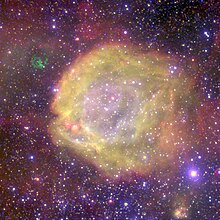Wolfova–Rayetova mlhovina


Wolfova–Rayetova mlhovina je mlhovina, která obklopuje Wolfovu–Rayetovu hvězdu.
WR mlhoviny se třídí různými způsoby. Jedním z prvních způsobů bylo třídění podle povahy a původu mlhoviny:[1]
- HII oblasti
- odvržené obálky hvězd
- bubliny foukané hvězdným větrem
Toto třídění vyžaduje podrobný výzkum každé mlhoviny, a proto byly vytvořeny další pokusy o rychlé třídění těchto mlhovin čistě na základě jejich vzhledu. WR mlhoviny mají často kruhový vzhled, takže mají pravděpodobně kulový tvar. Ostatní jsou nepravidelné, buď narušené obálky hvězd nebo vytvořené z hustých výtrysků.[2]
Příklady těchto typů mlhovin jsou NGC 6888, NGC 2359 nebo NGC 3199. Některé WR mlhoviny, jako například WR 104, mají výrazné spirální struktury, díky kterým byly dříve řazeny mezi spirální mlhoviny.
Reference
V tomto článku byl použit překlad textu z článku Wolf-Rayet nebula na anglické Wikipedii.
- ↑ CHU, Y.-H. Galactic ring nebulae associated with Wolf-Rayet stars. I - Introduction and classification [online]. Říjen 1981 [cit. 2016-06-06]. S. 195. Dostupné online. DOI 10.1086/159275. Bibcode 1981ApJ...249..195C. (anglicky)
- ↑ TOALÁ, J. A.; GUERRERO, M. A.; RAMOS-LARIOS, G., et al. WISE morphological study of Wolf-Rayet nebulae [online]. Červen 2015 [cit. 2016-06-06]. S. A66. Dostupné online. DOI 10.1051/0004-6361/201525706. Bibcode 2015A&A...578A..66T. arXiv 1503.06878v1. (anglicky)
Média použitá na této stránce
Autor: ESO, Licence: CC BY 4.0
This unique image shows AB7, one of the highest excitation nebulae in the Magellanic Clouds (MCs), two satellite galaxies of our own Milky Way. AB7 is a binary star, consisting of one WR-star — highly evolved massive star - and a mid-age massive companion of spectral type O. These exceptional stars have very strong stellar winds: they continuously eject energetic particles — like the "solar wind" from the Sun — but some 10 to 1,000 million times more intensely than our star! These powerful winds exert an enormous pressure on the surrounding interstellar material and forcefully shape those clouds into "bubbles", well visible in the photos by their blue colour. AB7 is particularly remarkable: the associated huge nebula and HeII region indicate that this star is one of the, if not the, hottest WR-star known so far, with a surface temperature in excess of 120,000 degrees ! Just outside this nebula, a small network of green filaments is visible — they are the remains of another supernova explosion.
Credit: ESO
About the Object
Name: LHA 115-N 76A Type: • Local Universe : Star : Grouping : Binary • Local Universe : Nebula • Nebulae Distance: 180000 light years
Colours & filters
Band Telescope Optical HeIII Very Large Telescope FORS1 Optical OIII Very Large Telescope FORS1 Optical H-I Very Large Telescope FORS1.
Autor: ESA/Hubble & NASA Acknowledgement: Judy Schmidt, Licence: CC BY-SA 4.0
Sparkling at the centre of this beautiful NASA/ESA Hubble Space Telescope image is a Wolf–Rayet star known as WR 31a, located about 30 000 light-years away in the constellation of Carina (The Keel).
The distinctive blue bubble appearing to encircle WR 31a, and its uncatalogued stellar sidekick, is a Wolf–Rayet nebula — an interstellar cloud of dust, hydrogen, helium and other gases. Created when speedy stellar winds interact with the outer layers of hydrogen ejected by Wolf–Rayet stars, these nebulae are frequently ring-shaped or spherical. The bubble — estimated to have formed around 20 000 years ago — is expanding at a rate of around 220 000 kilometres per hour!
Unfortunately, the lifecycle of a Wolf–Rayet star is only a few hundred thousand years — the blink of an eye in cosmic terms. Despite beginning life with a mass at least 20 times that of the Sun, Wolf–Rayet stars typically lose half their mass in less than 100 000 years. And WR 31a is no exception to this case. It will, therefore, eventually end its life as a spectacular supernova, and the stellar material expelled from its explosion will later nourish a new generation of stars and planets.
